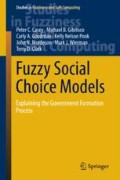Abstract
We are now in a position to present a one-dimensional fuzzy public choice modelPublic choice!fuzzy model designed to predict the outcome of the government formation process in parliamentary systems. Such a model allows us to represent flexibility in actors’ preferences and predict when those actors may make allowances for minor policy shifts as well as when they may prefer major policy shifts. This is because the fuzzy public choice model allows for broad areas of indifferenceIndifference in actor’s preference profiles. Moreover, a fuzzy model is more likely to predict stable outcomes by avoiding the intransitivity problem that plagues traditional models. We present two approaches to such a model. The first makes use of the fuzzy maximal set; the second makes use of the fuzzy Pareto set. We test both models using fuzzy preferences derived from the Comparative Manifesto Project (CMP) data.
Access this chapter
Tax calculation will be finalised at checkout
Purchases are for personal use only
Notes
- 1.
Percentages rounded to the nearest hundredth.
- 2.
All numbers reported for rile, fuzzy median, ranges of the support of fuzzy numbers, and other descriptive statistics are rounded to the nearest hundredths place.
- 3.
As defined by Shugart and Carey (1992).
- 4.
See Clark et al. (2008) for how thick indifferenceIndifference!thick reduces majority cycling without including institutional restraints.
- 5.
- 6.
Formally, an actor \(i\) possesses thick indifference if for \(a,b\in X\), \(a\ne b\nRightarrow aP_{i}b\) or \(bP_{i}a\) where \(P_{i}\) is the strict preference relation for player \(i\).
References
Benoit, K., Laver, M., Mikhalov, S.: Treating words as data with error: estimating uncertainty in the comparative manifesto measures. Am. J. Polit. Sci. 53(2), 49–513 (2009)
Casey, P.C.: Extracting fuzzy preference measures to predict government formation, MA thesis, Creighton University (2009)
Casey, P., Wierman, M.J., Gibilisco, M.B., Mordeson, J.N., Clark, T.D.: Assessing policy stability in iraq: a fuzzy approach to modeling preferences. Public Choice 151(3–4), 402–423 (2012)
Ching, S., Serizawa, S.: A maximal domain for the existence of strategy-proof rules. J. Econ. Theor. 78(1), 157–166 (1998)
Clark, T.D., Larson, J., Mordeson, J.N., Potter, J., Wierman, M.J.: Applying Fuzzy Mathematics to Formal Model in Comparative Politics. Springer, Berlin (2008)
Dasgupta, M., Deb, R.: Fuzzy choice functions. Soc. Choice Welfare 8, 171–182 (1991)
Georgescu, I.: The similarity of fuzzy choice functions. Fuzzy Sets Syst. 158, 1314–1326 (2007)
Laver, M., Shepsle, K.: Coalitions and cabinet goverment. Am. Polit. Sci. Rev. 84(3), 879–890 (1990)
Laver, M., Shepsle, K.: Making and Breaking Government: Cabinets and Legislatures in Parliamentary Democracies. Cambrige University Press, New York (1996)
Martin, L.W., Vanberg, G.: Policing the bargain: coalition government and parlamentary scrutiny. Am. J. Polit. Sci. 48(1), 13–27 (2004)
Masso, J., Neme, A.: A maximal domain of preferences for the division problem. Game. Econ. Behav. 37(2), 367–387 (2001)
Müller, W.C., Strøm, K.: Coaltion Governments in Western Europe. Oxford University Press, Oxford (2000)
Penn, E.M.: Alternative definitions of the uncovered set, and their implications. Soc. Choice Welfare 27(1), 83–87 (2006)
Shugart, M.S., Carey, J.M.: Presidents and Assemblies: Constitutional Design and Electoral Dynamics. Cambridge University Press, Cambridge (1992)
Sloss, J.: Stable outcomes in majorty rule voting games. Public Choice 15(1), 19–48 (1973)
Theis, M.F.: Keeping tabs on partners: the logic of delegation in coalition governments. Am. J. Polit. Sci. 45(3), 580–598 (2001)
Tsebelis, G.: Veto Players: How Political Institutions Work. Princeton University Press, Princeton (2002)
Warwick, P.V.: When far apart becomes too far apart: evidence for a threshold effect in coaltion formation. Brit. J. Polit. Sci. 35(3), 323–401 (2005a)
Warwick, P.V.: Do policy horizons structure the formation of parliamentary governments?: the evidence from an expert survey. Am. J. Polit. Sci. 49(2), 373–387 (2005b)
Author information
Authors and Affiliations
Corresponding authors
Rights and permissions
Copyright information
© 2014 Springer International Publishing Switzerland
About this chapter
Cite this chapter
Casey, P.C. et al. (2014). Predicting the Outcome of the Government Formation Process: Fuzzy Single-Dimensional Models. In: Fuzzy Social Choice Models. Studies in Fuzziness and Soft Computing, vol 318. Springer, Cham. https://doi.org/10.1007/978-3-319-08248-6_4
Download citation
DOI: https://doi.org/10.1007/978-3-319-08248-6_4
Published:
Publisher Name: Springer, Cham
Print ISBN: 978-3-319-08247-9
Online ISBN: 978-3-319-08248-6
eBook Packages: EngineeringEngineering (R0)

